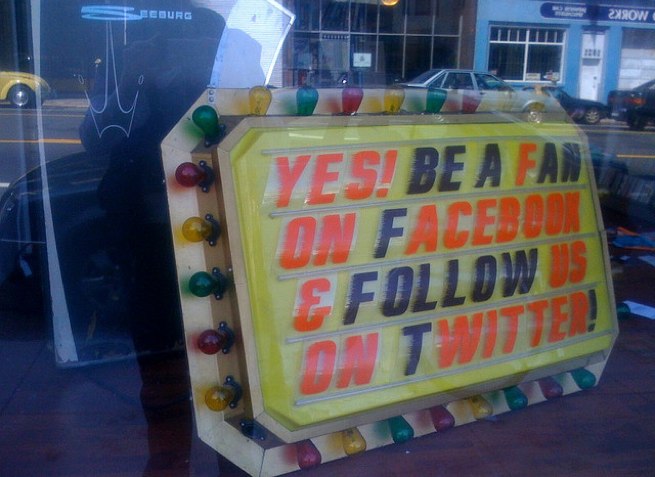
Facebook today shared data about the social networking activities of its U.S. members on Black Friday. The official information tells us nothing about the online or offline purchasing behaviors of Facebook’s massive audience, while third-party calculations make it seem like the social network played a non-existent role in driving traffic or sales.
[aditude-amp id="flyingcarpet" targeting='{"env":"staging","page_type":"article","post_id":579940,"post_type":"story","post_chan":"none","tags":null,"ai":false,"category":"none","all_categories":"social,","session":"A"}']On Black Friday, Facebook said that people were talking most about retailers’ Pages — Walmart, Toys “R” Us, Macy’s, and Amazon in particular. There were 252,023 unique users talking about Walmart, 223,551 people discussing Toys “R” Us, 158,062 folks chatting about Macy’s, and 108,339 individuals conversing about Amazon on Black Friday, a Facebook spokesperson told VentureBeat.
Mentions of “Black Friday,” “Shopping,” “Mall,” and “Sales,” also spiked exponentially among U.S. users. The revelations are akin to saying people ate a lot of turkey and pumpkin pie on Thanksgiving Day.
AI Weekly
The must-read newsletter for AI and Big Data industry written by Khari Johnson, Kyle Wiggers, and Seth Colaner.
Included with VentureBeat Insider and VentureBeat VIP memberships.
The social network measures the number of unique users who create a story about a Page in a seven-day period to calculate a “People Talking About This” ranking (PTAT). For the week ending on Black Friday, the top 25 PTAT-ranked Pages were all retailer Pages, as listed below.
What can we make of the list? Simply that retailer Pages were the most popular variety of Pages (shocker, I know), and that Walmart did a better job than anyone else at getting Facebook members in the U.S. to talk about its Page.
Facebook did not share the correlation between its PTAT calculations and online sales or store traffic. This strikes me as a mistake.
Black Friday was part of a record-breaking holiday shopping weekend. According to the National Retail Foundation, about 89 million Americans visited brick-and-mortar stores on Black Friday alone. The entire weekend, save for Cyber Monday, brought in about $60 billion in sales, with the average person spending about 40 percent of his or her total bill online.
A report from IBM said that Black Friday online sales were up 20.7 percent from last year. ComScore pegged e-commerce spending on Black Friday at $1.042 billion, making the pseudo holiday the heaviest online spending day of the year.
By golly, you’d certainly expect Facebook, which connects consumers to the brands they love, to have facilitated some of those transactions. But instead of any proclamation from Facebook about being a platform that contributed in a meaningful way to a record-breaking day, we get some fuzzy findings about the Pages people were talking about. Whoopee.
[aditude-amp id="medium1" targeting='{"env":"staging","page_type":"article","post_id":579940,"post_type":"story","post_chan":"none","tags":null,"ai":false,"category":"none","all_categories":"social,","session":"A"}']
Talk is cheap. IBM’s Digital Analytics Benchmark report concluded this: “Shoppers referred from Social Networks such as Facebook, Twitter, LinkedIn, and YouTube generated 0.34 percent of all online sales on Black Friday, a decrease of more than 35 percent from 2011.”
Let me reiterate the finding: Only around one-third of a percent of Black Friday online sales can be directly linked back to any social service. Out of all online sessions on Black Friday, Facebook specifically accounted for 0.68 percent of referral traffic, according to IBM. Twitter meanwhile accounted for zero percent of referral traffic.
I suspect IBM’s calculations are far more bleak than reality, especially as click-throughs don’t always correlate to immediate conversions. Facebook, as we know, believes that impressions, even those that don’t drive a direct purchase, add up to value, hence the new ad-tracking tools for marketers.
[aditude-amp id="medium2" targeting='{"env":"staging","page_type":"article","post_id":579940,"post_type":"story","post_chan":"none","tags":null,"ai":false,"category":"none","all_categories":"social,","session":"A"}']
Still, I’m left wondering how much of a role, if any, Facebook, Twitter, or any other social network played in driving purchases or changing consumer behavior on Black Friday. So far, it sounds like the networks spawned a lot of talk but no action.
— —
Top 25 PTAT for Black Friday 2012
People Talking About This (PTAT) is the number of unique users who have created a “story” about a page in a seven-day period. Stories are items that display in news feed, created by users when they like a Page, post on the Page wall, like a post, comment on a post, share a post, etc.
- Walmart
- Toys “R” Us
- Macy’s
- Amazon
- Converse
- Foot Locker
- Spencer’s
- Aeropostale
- Target
- Kohl’s
- Coach
- Champs Sports
- Best Buy
- Finish Line
- Ace Hardware
- Keurig
- Forever 21
- Lowe’s Home Improvement
- Gap
- JCPenney
- Bed Bath & Beyond
- Sears
- QVC
- Build-A-Bear Workshop
- Disney Store
Photo credit: heather/Flickr
VentureBeat's mission is to be a digital town square for technical decision-makers to gain knowledge about transformative enterprise technology and transact. Learn More
